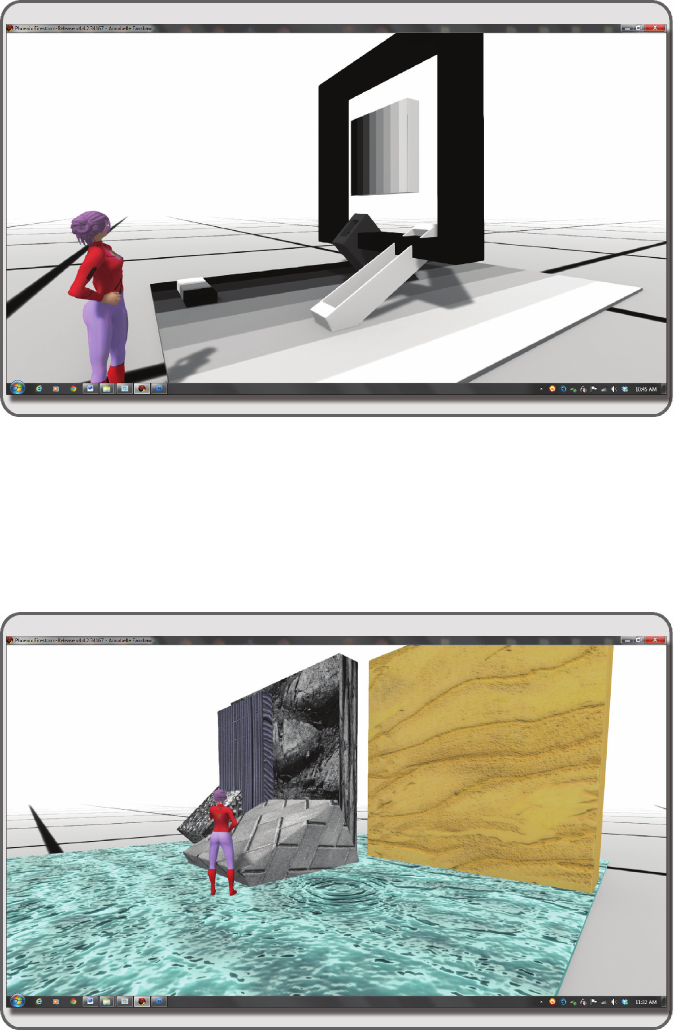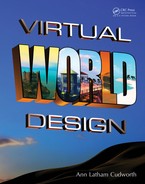
54 Virtual World Design
4.4.5 direCTional ConTrasTs
When you see a weather vane spinning on the top of a house or a ag ying straight out from a pole in
a strong wind, you are seeing two simple examples of directional contrast. In each case, there is a stable
element (the house and the agpole, respectively) as well as the moving or “unstable” element (the weather
vane and the ag, respectively). The visual direction of the stable elements in these compositions is gener-
ally vertical; both the house and the agpole rise from the ground. The visual direction of the weather vane
and the ag while generally horizontal will also change orientation with the wind and create a directional
contrast. Figure4.14 provides a simple example of sculptural directional contrast.
4.4.6 sTruCTural ConTrasTs
Structure in nature tends to follow some standard rules. Small on top of large, such as in the branching of a
typical tree, or graduated volumes, such as you might nd in a chambered nautilus shell. In buildings, you
tend to nd some sort of internal structure that connects the oors and rooms in a cohesive pattern, until
there is an earthquake. By utilizing the physics engine in a virtual world, you can create lovely random struc-
tural contrast as stacked objects fall to the ground. Figure4.15 presents an image of a structural collapse and
the structural contrast it creates. On one side, the elements stand straight and tall, and on the other side, they
are in a complex pile at the base.
4.4.7 size ConTrasTs
The creation of size contrast can have profound effects on how a 3D design is understood and accepted. The
contrast in size between the elements contributes to the observer’s understanding of the relative importance
FIGURE 4.13 Screen grab from OpenSim showing a virtual representation of contrast of form in 3D, with two objects
that exemplify this: (1) a geometrically based object (sphere) and (2) an organically based object (tree trunk).

55Concepts in 3D Design for Virtual Environments
FIGURE 4.14 Screen grab from OpenSim demonstrating directional contrast in a virtual environment by using angled
lines and tapering shapes to move the eye in different directions.
FIGURE 4.15 Screen grab from OpenSim illustrating a virtual version of structural contrast in 3D composition that
was created by the actions of inworld physics on columns of physically enabled objects.

56 Virtual World Design
of the elements, and the contrast between the observer’s scale, as either an avatar or a real person, contributes
to the psychological impact on the observer. Imagine how it feels to walk from a wall diagram displaying the
various sizes of whales and into the great hall of a museum where a full-scale model of a whale is hanging
over your head. This experience is memorable in both virtual and physical worlds. Size contrast can also
occur within a family of forms, such as the relative scale of the planets in our solar system or all the various
frames in the window of a framing shop. Look at Figure4.16 for an example.
4.4.8 Color ConTrasTs
Your 3D design will benet from the application of color contrast. This contrast does not need to be profound
if the style of your design does not ask for it. In fact, a subtle range of color, punctuated with some spots of
intense color, is visually interesting. Likewise, the use of light and dark, warm and cool colors playing across
your composition can inject energy and excitement into the message embodied in your design. There is much
more discussion about color and its uses in 3D design in Chapter 7. Look at Figure4.17 for shades of gray
color contrasts in a 3D design.
4.4.9 TexTure ConTrasTs
Until haptic devices allow us to “feel” virtual surfaces, texture is only visual in a virtual environ ment. This is
not a setback to 3D design if the visual textures are chosen and applied properly to your objects. Figure4.18
comprises an assemblage of objects with various textures to show the dynamic range (smooth, rough, shiny,
dull, complex, simple) that can be achieved in visual textures. Also for your consideration is the script-driven
interactive possibility that these textures can be animated or the objects could change textures in response to
an avatar’s presence or touch (mouse click).
FIGURE 4.16 Screen grab from OpenSim, virtually demonstrating size contrast in 3D. Here this is shown by using in
a box-like family of forms.

57Concepts in 3D Design for Virtual Environments
FIGURE 4.17 Screen grab from OpenSim showing a virtual version of color contrast in 3D design using shades of gray.
FIGURE 4.18 Screen grab from OpenSim virtually demonstrating texture contrasts shown on the forms of a 3D design.

58 Virtual World Design
4.4.10 densiTy/opaCiTy ConTrasTs
Density is dened in the Encarta Dictionary as the “concentration of things within an area in relationship
to the size of that area,” but the word also means the relative transparency of a surface or an atmosphere.
Great quantities of particles in a virtual environment can create dense visual effects like smoke and fog,
and at the virtual shoreline, there is a horizontal line of contrast between a transparent virtual liquid and an
opaque virtual solid. Figure4.19 shows a 3D design that utilizes elements with varying kinds and degrees
of density.
4.4.11 graViTaTional ConTrasTs
The laws of gravity have a part to play in 3D design. When a 3D design seems to defy these laws, the visitor
will experience things like excitement, anxiety, and possibly fear. In Figure4.20, you will see some simple
examples of how a stacked form can create gravitational contrast by simply turning it upside down. There
is a sense of stability on one side and instability on the other. In more complex designs, you can incorporate
multiple instances of this kind of contrast to create sophisticated contrast patterns.
4.4.12 soCial ConTrasT
In some ways, social contrast is related to density, especially when dened in terms of visitor numbers in your
3D environment during an event and afterward. There is also the social contrast between the more popular
versus less-popular destinations in virtual worlds, one region teeming with many avatars next to a region that
is completely empty. As a 3D designer and builder of virtual environments, you should be aware that there
FIGURE 4.19 Screen grab from OpenSim virtually showing an example of 3D design with a variety of density and
opacity in its composition.
..................Content has been hidden....................
You can't read the all page of ebook, please click here login for view all page.
